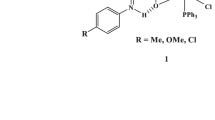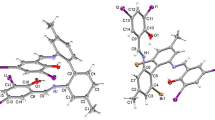Abstract
Novel dinuclear peroxo complexes of tungsten with coordinated cystine of the type A2[W2O3(O2)4(cystine)].4H2O, A = Na (1) or K (2) have been synthesized from the reaction of A2WO4,cysteine and 30% H2O2at pH 2.5. The synthesized compounds were characterized by elemental analysis, spectral and physico-chemical methods. The two W(VI) centres with side-on bound peroxo groups of the dinuclear complex species are bridged by an oxo group and a cystine ligand, formed from the oxidation of cysteine. Cystine occurring as zwitterion binds the metal centers of the complex ion through O(carboxylate) atoms leading to hepta co-ordination around each W(VI). The compounds exhibit high stability toward decomposition in solution of acidic as well as physiological pH and serve as weak substrates to catalase, undergoing degradation in presence of the enzyme at a rate much slower relative to H2O2. The compounds efficiently oxidized GSH to GSSG, a reaction in which only two of the peroxide groups of the complex species were found to participate. The compounds induce strong inhibitory effect on alkaline phosphatase activity with a potency higher than that of the free cystine, tungstate, or peroxotungstate.
Similar content being viewed by others
References
Johnson MK, Rees DC, Adams MWW: Tungstoenzymes. Chem Rev 96: 2817–2839, 1996
Enemark JH, Cooney JJA, Wang JJ, Holm RH: Synthetic analogues and reaction systems relevant to the molybdenum and tungsten oxotransferases. Chem Rev 104: 1175–1200, 2004
Louie AY, Meade TJ: Metal complexes as enzyme inhibitors. Chem Rev 99: 2711–2734, 1999
Moore PS, Jones CJ, Mahmood N, Evans IG, Goff M, Cooper R, Hay AJ: Anti- (human immunodeficiency virus) activity of polyoxotungstates and their inhibition of human immunodeficiency virus reverse transcriptase. Biochem J 307: 129–134, 1995
Stankiewiez PJ, Gresser MJ: Inhibition of phosphatase and sulfatase by transition state analogues. Biochemistry 27: 206–212, 1988
Li J, Elberg G, Gefel D, Shechter Y: Permolybdate and Pertungstate- potent stimulators of insulin effects in rat adipocites: mechanism of action. Biochemistry 34: 6218–6225, 1995
Van-Etten RL, Waymack PP, Rehkop DM: Transition metal ion inhibition of enzyme catalysed phosphate ester displacement reactions. J Am Chem Soc 96: 6782–6785, 1974
Soman G, Chang YC, Graves DJ: Effect of oxyanions of the early transition metals on rabbit skeletal muscle phosphorylase. Biochemistry 22: 4994–5000, 1983
Heo YS, Ryu JM, Park SM, Park JH, Lee HC, Hwang KY, Kim J: Structural basis for inhibition of protein tyrosine phosphatase by keggin compounds phosphomolybdate and phosphotungstate. Exp Mol Med 34: 211–223, 2002
Crans DC, Smee JJ, Gaidamauskas E, Yang L: The chemistry and biochemistry of vanadium and biological activities exerted by vanadium compounds. Chem Rev 104: 849–902, 2004
Kustin K: Perspective on vanadium biochemistry. In: A.S. Tracy and D.C. Crans (eds). Vanadium Compounds Chemistry, Biochemistry, and Therapeutic Applications. Oxford University Press, New York, 1998, pp. 170–185
Crans DC: Peroxo hydroxylamido and acac derived vanadium complexes: Chemistry, biochemistry and insulinmimetic action of selected vanadium compounds. In: A.S. Tracy and D.C. Crans (eds). Vanadium Compounds Chemistry, Biochemistr, and Therapeutic Application. Oxford University Press, New York, 1998, pp. 82–103
Rehder D, Bashipoor M, Jantzen S, Schmidt H, Farahbakhsh M, Nekola H: Structural and functional models for biogenic vanadium compounds. In: A.S. Tracy and D.C. Crans (eds). Vanadium Compounds, Chemistry, Biochemistry, and Therapeutic Applications. Oxford University Press, New York, 1998, pp. 60–71
Shechter Y, Goldwaser I, Mironchik M, Fridkin M, Gefel D: Historic perspective and recent developments on the insulin like actions of vanadium; toward developing vanadium based drugs for diabetes. Coord Chem Rev 237: 3–11, 2003
Djordjivic C, Vuletic N, Renslo ML, Puryear BC, Alimard R: Peroxo heteroligand vanadates(V): Synthesis, spectra-structure relationships, and stability toward decomposition. Mol Cell Biochem 153: 25–29, 1995
Shaver A, Ng JB, Hall DA, Posner BI: The Chemistry of peroxovanadium compounds relevant to insulin mimesis. Mol Cell Biochem 153: 5–15, 1995
Kenneth S, Kirshenbaum KS, Sharpless KB: Improved procedure for the Tungstate catalysed epoxidation of α, β. unsaturated acids. J Org Chem 50: 1979–1982, 1985
Bortolini O, Furia FD, Modena G, Seraglia R: Metal catalysis in oxidation of peroxides. Sulfide oxidation and olefine epoxidation by dil H2O2,catalysed Mo and W derivatives under phase transfer conditions. J Org Chem 50: 2688–2690, 1985
Gresley NM, Griffith WP, Laemmel AC, Nogueira HIS, Parkin BC: Studies on polyoxo and polyperoxo metalates part 5: Peroxide catalised oxidation with heteropolyperoxo tungstates and molybdates. J Mol Catal A 117: 185–198, 1997
Dickman MH, Pope MT: Peroxo and superopxo complexes of chromium, molybdenum and tungsten. Chem Rev 94: 569–584, 1994
Campbell NJ, Dengel AC, Edwards CJ, Griffith WP: Studies on transition metal peroxo complexes. Part 8: The nature of peroxomolybdates and peroxotungstates in aqueous solution. JCS Dalton Trans: 1203–1207, 1989
Dengel AC, Griffith WP, Powell RD, Skapski AC: Studies on transition metal peroxo complexes. Part 7: Mo(VI) and W(VI) carboxylato peroxo complexes and the Xray crystal strucures of K2[MoO(O2)2(glyc)]·2H2O. JCS Dalton Trans: 991–995, 1987
Bhengu TT, Sanyal DK: Ligands effects on the stability of some Mo(VI) and W(VI) peroxo complexes. Part 2. Study of the thermal stability. Thermochimica Acta 397: 181–197, 2003
Piquemal JY, Halut S, Bregault JM: Novel Distorted pentagonal-pyramidal coordination of anionic oxodiperoxo molybdenum and tungsten complexes. Angew Chem Int Ed 37: 1146–1149, 1998
Chakravorti MC, Ganguly S, Bhattacharjee M: First electrosynthesis of transition metal peroxocomplexes. Synthesis, characterisation and reactivity of molybdenum and tungsten heteroligand peroxocomplexes. Polyhedron 12: 55–58, 1993
Chaudhuri MK, Ghosh SK, Islam NS: First synthesis and structural assessment of alkali-metal triperoxo-vanadate(V).A[V(O2)3]. Inorg Chem 24: 2706–2707, 1985
Jeffery GH, Basset J, Mendham J, Denny RC: Vogel's Textbook of Quantitative Inorganic Analysis Including Elementary Instrumentel Analysis, 4th edn, Longman Group Limited, London, pp. 486–487, 1978
Ellmen GL: Tissue sulfhydryl groups. Arch Biochem Biophy 82: 70–77, 1959
Nakamato K(ed).: Infrared and Raman Spectra of Inorganic and Coordination compounds. Part B,5th edn. J Wiley & Sons, New York, 1997, p. 210
Nakamato K (ed).: Infrared and Raman Spectra of Inorganic and Coordination Compounds. Part B, 5th edn. J Wiley & Sons, New York, 1997, pp. 60, 71
Ravishankar HN, Rao AVS, Ramasarma T: Catalase degrades dipeoxovanadate and releases oxygen. Arch Biochem Biophys 321: 477–484, 1995
Chaudhuri MK, Paul PC: Complexes of peroxovanadates (V) containing chelated cystinate as the co-ligand: Synthesis and spectroscopic studies. Ind J Chem 31A: 466–468, 1992
Melby LR: Cysteine and Cysteine ester complexes with Mo(V) and Mo(VI). Inorg Chem 8: 349–353, 1969
Chow ST, McAuliffe CA. In: Transition metal complexes containing tridentate amino acids. S. Lippared (ed). Progress in Inorganic Chemistry, Vol 19, Wiley Interscience, New York, 1975, 51–104
Ravindranath V: Animal Models and Molecular Markers for Cerebral Ischemia Reperfusion Injury in Brain. In: L. Packer (ed). Methods in enzymology, Vol 233, Academic press Inc., 1994, pp. 613–617
Shisheva A, Ikonomov O, Shechter Y: The protein tyrosine phosphatase inhibitor, pervanadate, is a powerful antidiabetic agent in streptozotocin-treated diabetic rats. Endocrinology 133: 507–510, 1994
Author information
Authors and Affiliations
Corresponding author
Rights and permissions
About this article
Cite this article
Hazarika, P., Kalita, D., Sarmah, S. et al. New oxo-bridged peroxotungsten complexes containing biogenic co-ligand as potent inhibitors of alkaline phosphatase activity. Mol Cell Biochem 284, 39–47 (2006). https://doi.org/10.1007/s11010-005-9011-8
Received:
Accepted:
Published:
Issue Date:
DOI: https://doi.org/10.1007/s11010-005-9011-8




